A Case of the Nibbles
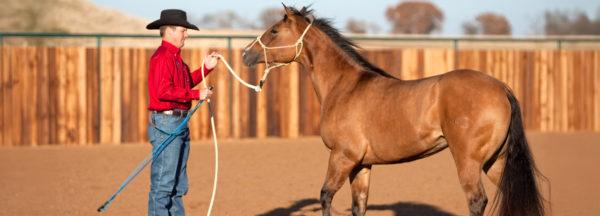
Dealing with a “Mouthy Horse”
Mouthy horses are like little kids; they’ve got nothing to do and all day to do it in. If you don’t give a kid something to do, he’ll stick things in his mouth, climb on the furniture, draw on the walls, or do a number of things that’ll drive you crazy. Horses need both mental and physical stimulation to be happy and content. If you don’t give your horse a job and keep his mind busy, he’ll find an outlet for his pent up energy and a way to keep his mind busy. In a lot of cases, that results in the horse developing some sort of vice (weaving, cribbing, etc.) including being mouthy—constantly playing with your shirt sleeve, nibbling on the lead rope or chewing on the Handy Stick, for example. Very athletic horses and young horses tend to develop this habit. The bad news is that mouthy behavior often turns into biting—a very dangerous vice. The good news is if you give your horse a job, as simple as making him move his feet forwards, backwards, left and right, his mouthiness will disappear.
Don’t Invite the Problem
If you know your horse tends to get mouthy and nibbles on you, protect your space and take the temptation away from him to begin with. Don’t let him get close enough to mouth on you. Anytime you’re with him, keep him out of your personal hula hoop space—a 4-foot circle that surrounds you and serves as your safety zone. When you are working with a horse, always imagine that there’s a 4-foot circle drawn around you —almost like an invisible electric fence. Unless you invite the horse into your personal hula hoop space, he should keep a respectful, safe distance from you.
Most injuries people suffer while working with horses occur because the horse was too close to them. Think about all the times people get hurt by horses. The horse bites them, kicks them, strikes at them, runs over the top of them, etc. Each time the horse was in the person’s personal hula hoop space. You can’t be injured if the horse is kept outside of that circle. A horse can’t bite you if he is 4 feet away from you; he can’t kick you if his hind legs don’t get any closer to you than 4 feet; and he can’t run over you if his chest is outside of your hula hoop space. As long as you keep the horse away from you, if he does get the urge to put something in his mouth, it’ll be the lead rope, not you.
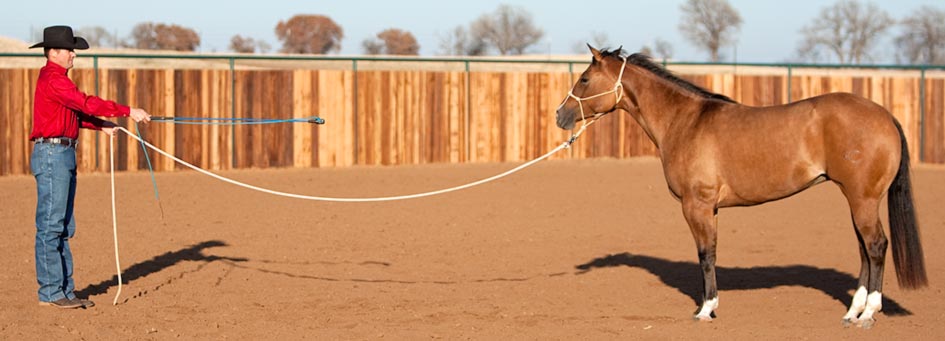
If you know your horse likes to get mouthy, don’t allow him to get close to you. Instead, keep him out of your personal hula hoop space.
Make Those Feet Move
Let’s say that your horse grabs the halter in his mouth as you go to put it on. As soon as he grabs it, instead of trying to pull it out of his mouth, stand beside him and tug one end of the halter up in his mouth and then the other end to make him feel uncomfortable. When you do that, the horse might throw his head up in the air, but you’ll continue to tug up on the halter. You’re not really hurting him, but you are making him feel uncomfortable. Do that for ten seconds and then let the horse lower his head and spit the halter out of his mouth. Then dare him again by waving the halter in front of his nose. If he grabs it, repeat the process. You’ll only have to do that two or three times, and pretty soon, those horses wise up and want no part of grabbing a hold of the halter.
The same theory applies to the Handy Stick. If your horse grabs a hold of the stick, stand in front of him and start pushing it in and out of his mouth like it’s a toothbrush. Don’t ram it in and out of his mouth so hard that it hurts him, just quickly slide it in and out of his mouth to make him feel uncomfortable. He might stick his head up in the air, or even back up—just follow him and continue to move the stick in his mouth. After ten to fifteen seconds, pull the same time. He can’t mouth on you and move his feet, especially if you make him hustle with energy and do lots of changes of direction. If you’re consistent, it won’t take long for the horse to connect the two together. When he gets mouthy, you’ll make his feet move. One of the best ways to stop a mouthy horse, and especially horses that bite, is to back them up. Backing Up is a very humbling exercise for a horse to do. When a horse gets mouthy or tries to bite you, it’s a very forward action; he’s coming forward to get you. When you back him up, it’s the complete opposite; he’s being submissive to you by moving out of your space.
When it comes to dealing with mouthy horses, the most important thing to keep in mind is that the busier you keep their feet and the more you keep them mentally stimulated, the less mouthy they will be. Horses that are mouthy are searching for interaction, so give them the attention they’re wanting by making their feet move.
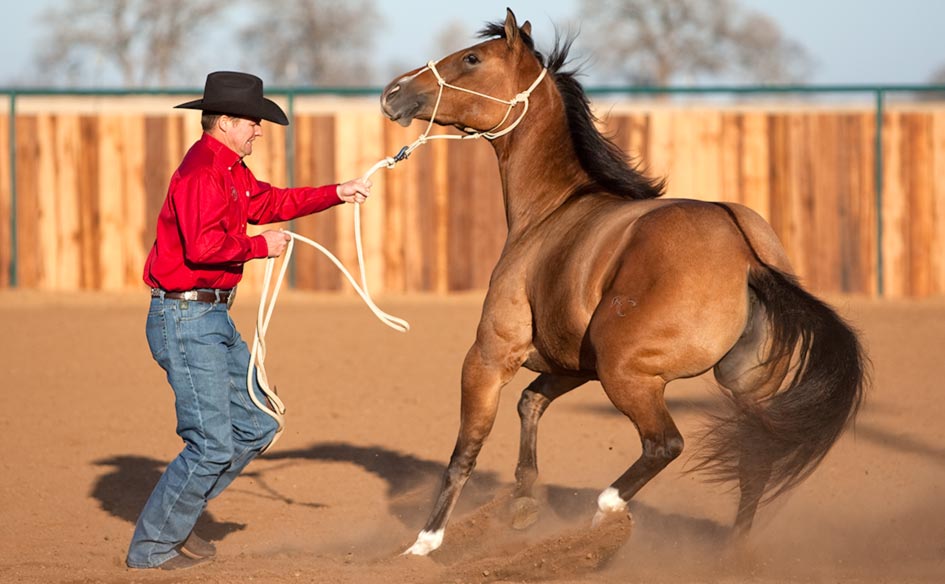
When your horse gets mouthy, instantly put his feet to work and turn a negative into a positive. Backing Up is one of the best exercises you can do with a horse that likes to mouth.
Return the Favor
Then there are some horses (like foals and yearlings) that like to put things in their mouth—the halter, lead rope, Handy Stick, etc. Most people’s first reaction when the horse grabs a hold of the lead rope or halter is to try and tug the object out of his mouth. However, the more you try to pull something away from them, the mouthier they will get. It’s like a puppy with a toy. The more you try to yank it away, the more he grits his teeth and hangs onto it. Instead of getting into a tug-o-war with the horse, use reverse psychology and “mouth” him back. Use both of your hands to vigorously rub the horse’s muzzle for a good twenty seconds. While you’re not hurting the horse, you’re rubbing him firmly enough to make him feel uncomfortable. It’s like when your uncle would scuff your head at a family get-together. Every kid in the world hates that. It didn’t hurt when he tousled your hair, but it was annoying and you didn’t like it, and you soon learned how to avoid him. It’s the same philosophy with your horse. If he wants to get mouthy, take all the fun out of it for him. Rough up his muzzle with your hands. If you’re consistent, and do it vigorously enough, pretty soon the horse is like, “Man, I’m going to keep my lips to myself because I don’t like this guy mouthing me.”
And don’t worry, you won’t make your horse head shy or hard to bridle because you are only going to “rough him up” so to speak when he trys to get mouthy. If he doesn’t get mouthy, you’ll leave him alone.
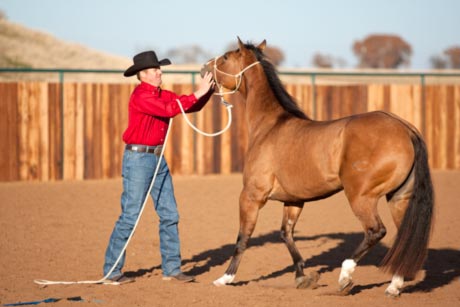
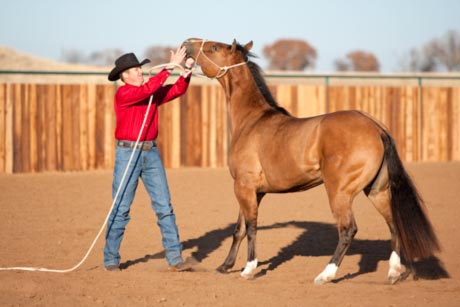
If your horse mouths you, mouth him back by vigorously rubbing both of your hands on his muzzle. It won’t take long for your horse to realize that getting mouthed isn’t much fun.
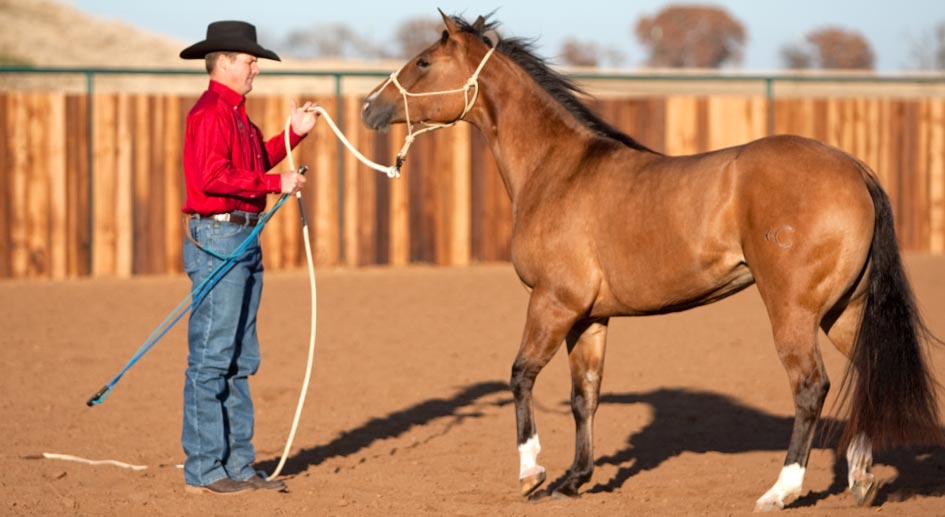
Prevention Is Better than Cure
The best way to handle a horse that gets mouthy is to never let the problem develop in the first place. Horses that get mouthy are often bored and looking for attention. The more you work with your horse, moving his feet forwards, backwards, left and right, the more he’ll use the thinking side of his brain and the more respectful he’ll get. A horse that respects your space doesn’t lip on you; he stays out of your personal hula hoop space unless you invite him in. You also need to be careful that you’re not encouraging the horse to be mouthy. People often make this mistake with young horses like foals and weanlings. Because they’re small, they allow the foal to nuzzle them, play with their shirt, etc. Then when the foal grows up to be a 1,200 pound pushy, disrespectful horse, they wonder where they went wrong.
Don’t wait until the horse gets mouthy to do the groundwork; start earning his respect and attention before a problem shows up. I personally never lead my horses to where I’m going. Instead, I back them up, practice sidepassing, do the C-Pattern, etc., moving their feet forwards, backwards, left and right. I never waste an opportunity to teach my horses something. The busier you keep a horse’s feet and the more you keep him mentally stimulated, the less mouthy he will be. Remember, horses that are mouthy are searching for interaction, so give them your attention by moving their feet.
Bait Him
Let’s say that your horse grabs the halter in his mouth as you go to put it on. As soon as he grabs it, instead of trying to pull it out of his mouth, stand beside him and tug one end of the halter up in his mouth and then the other end to make him feel uncomfortable. When you do that, the horse might throw his head up in the air, but you’ll continue to tug up on the halter. You’re not really hurting him, but you are making him feel uncomfortable. Do that for ten seconds and then let the horse lower his head and spit the halter out of his mouth. Then dare him again by waving the halter in front of his nose. If he grabs it, repeat the process. You’ll only have to do that two or three times, and pretty soon, those horses wise up and want no part of grabbing a hold of the halter.
The same theory applies to the Handy Stick. If your horse grabs a hold of the stick, stand in front of him and start pushing it in and out of his mouth like it’s a toothbrush. Don’t ram it in and out of his mouth so hard that it hurts him, just quickly slide it in and out of his mouth to make him feel uncomfortable. He might stick his head up in the air, or even back up—just follow him and continue to move the stick in his mouth. After ten to fifteen seconds, pull the stick out and leave the horse alone. Usually, the horse will lower his head and lick his lips as soon as the stick is pulled out.
Then bait him again by waving the end of the stick around the end of his nose. In most cases, the horse will grab it again, and when he does you’ll repeat the same steps. It usually takes three times for a horse to actually start to understand the lesson. By the third or fourth time, your horse will not want to grab a hold of that stick because every time he grabs a hold of it, you make him feel uncomfortable. You’re saying to the horse, “Hey, if you want to chew the stick, you can chew it, but you’re going to feel uncomfortable.”
You might be thinking, “Well Clinton, isn’t that going to make the horse head shy or not want to accept the bit?”
No, because you’re only making him feel uncomfortable when he gets mouthy. You’re not physically putting the halter or stick in his mouth and then roughing him up. He’s choosing to take the bait and be mouthy. As long as you use common sense and only make him feel uncomfortable when he grabs a hold of the object, you don’t have to worry about him getting head shy or not accepting the bit.
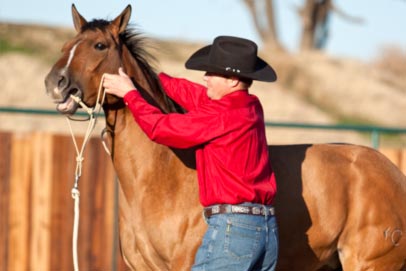
Rather than trying to pull the halter out of your horse’s mouth when he grabs a hold of it, see-saw it up and down in his mouth and use reverse psychology.
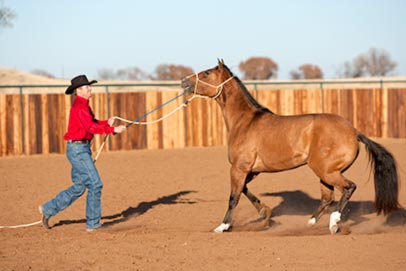
If your horse grabs a hold of the Handy Stick, act like you’re brushing his teeth with it by moving it back and forth in his mouth.
Punish Thy Self
Another tactic is to make the horse think that he’s punishing himself. For example, a lot of young horses like weanlings or yearlings get mouthy. They’ll come up to you and start nibbling on the sleeve of your shirt or your jeans. If your horse walks up to you and starts playing with your sleeve, without even looking at him, flap your elbow out to the side so that he runs into it with his nose and feels uncomfortable. You have to time it just right so that at the same time he leans forward to play with your shirt, he runs into your elbow. The secret is not to look at him or act like you’re moving your arm on purpose. It’s like your elbow just developed a nervous twitch. If you look at the horse, it’s like you’re acknowledging that you’re the one making him feel uncomfortable. You want the horse to think that he’s doing it to himself. Every time he leans in to nibble on you, he runs into your elbow. Horses always learn faster when they teach themselves the lesson. It wont be long before your horse is like “Man, I really need to keep my lips to myself because I seem to be running into his elbow.”
Will Treats Make My Horse Mouthy?
Feeding your horse treats won’t teach him to be mouthy as long as you give him treats correctly. Never give your horse a treat if he’s looking for it. When I give my horses a treat, I want it to be a surprise. I don’t use treats to bribe the horse or win his affection. Treats are just a bonus for a job well-done. A treat should always be a surprise. If you constantly feed your horse treats, he’ll be looking for them, and that’s when he’ll start mouthing your shirt, pockets and hands. When you give your horse treats, feed him one at a time, and only give them when he’s not expecting it. If he is looking for a treat, he doesn’t get one.
Want To Learn More? SIGN UP FOR OUR LOYALTY PROGRAM
Master your horsemanship training through Clinton’s step-by-step method videos by joining the No Worries Club today. Becoming a club member ensures you get VIP pricing on all of Clinton’s must-have training tools and resources. Plus, you’ll enjoy all the phenomenal benefits that come with club membership!


